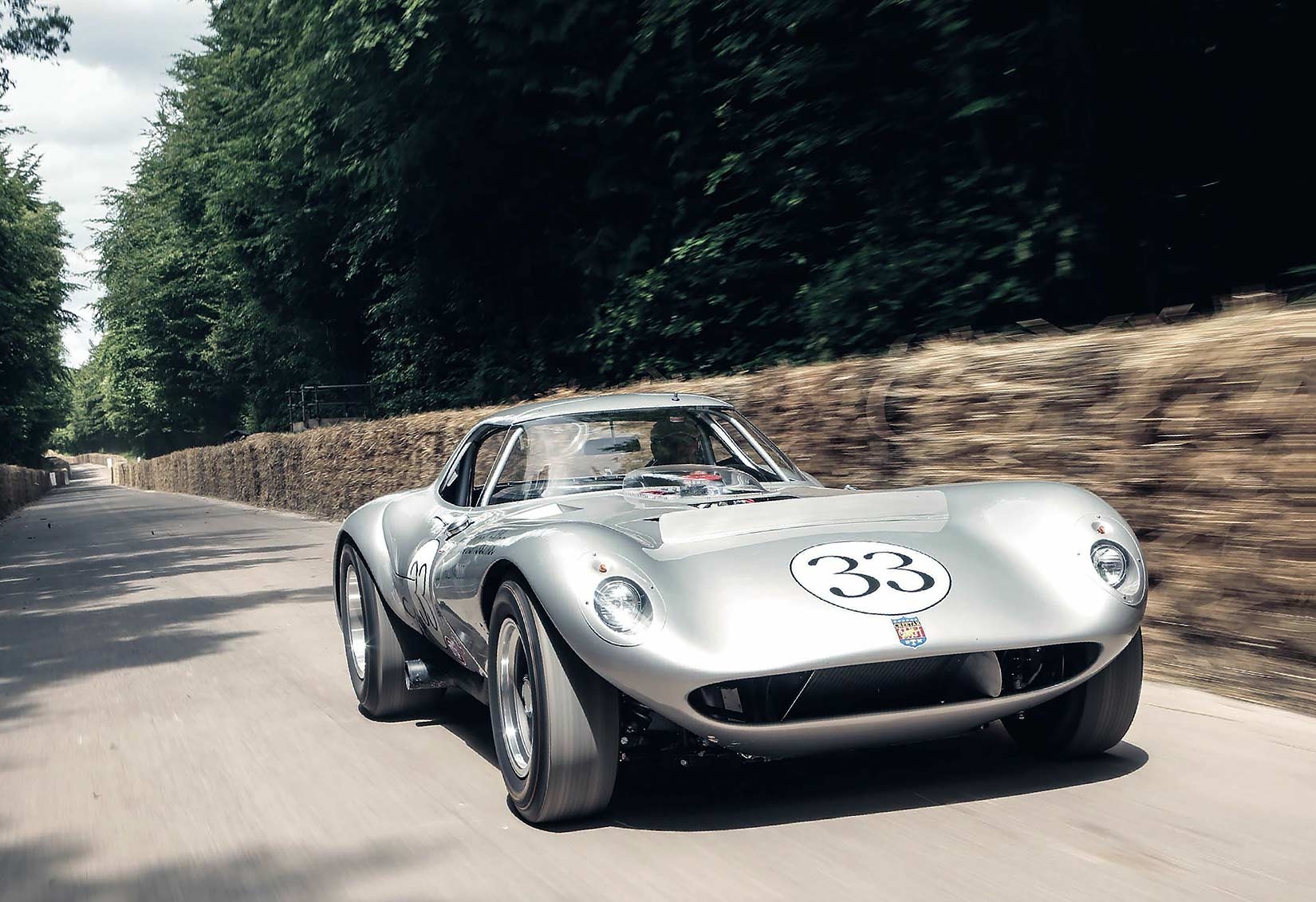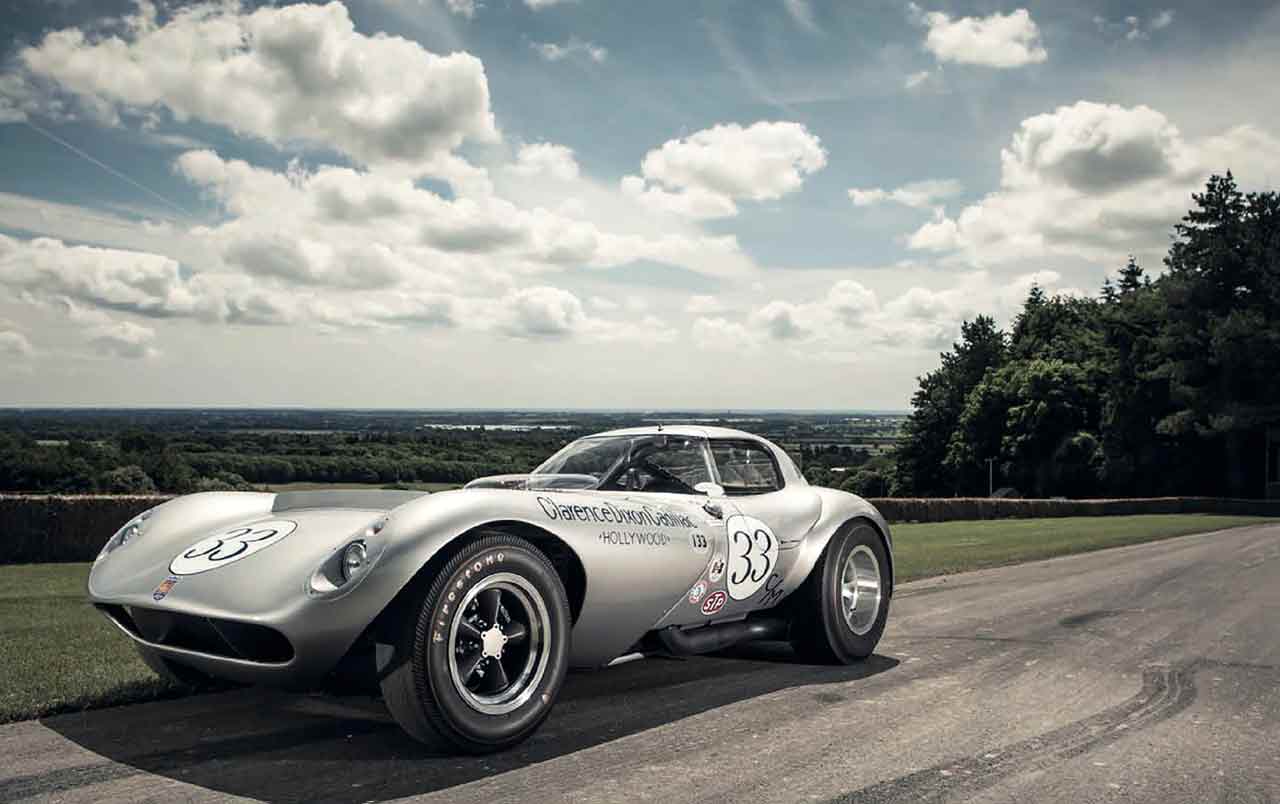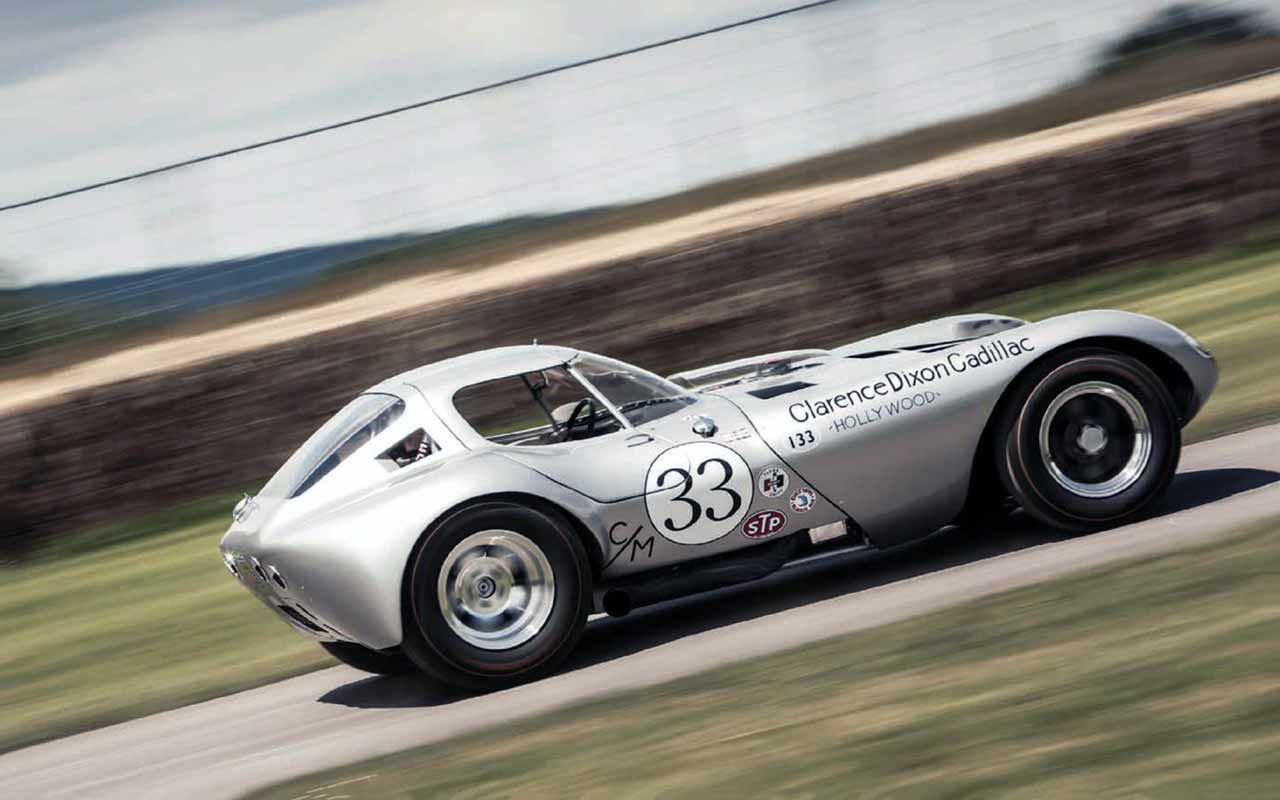
Taming a wild Cheetah 550bhp monster tested. Wild animal: the Cheetah offered monumental pace for the very brave. American monster Mick Walsh enjoys a white-knuckle drive in a Chevy-powered Cheetah. Mick Walsh braves Goodwood in a Cheetah: the fearsome Chevrolet-powered GT that was quicker than a Cobra but cooked its drivers. Photography Tony Baker. Archive Allen Kuhn.
The beast of Anaheim
style=”flat” size=”7″]“I could have been a contender,” was Marlon Brando’s famous line as Terry Malloy in On The Waterfront, but it would be just as apt for Bill Thomas, the Californian creator of the Cheetah. ‘Mister Corvette’ was Blue Riband through and through, and it must have really pained him when he saw the new Cobra whip the Sting Rays at Riverside in February ’1963.
A plan was hatched, with covert help from Chevrolet, to build a Cobra rival with a target 100 production for homologation. With new premises in Anaheim and teamed with race-car chassis expert Don Edmunds, they constructed the prototype from a basic set of drawings based around the key dimensions of engine, rear end and wheels – all chalked out on the workshop floor. The result was a chrome-moly tubular spaceframe with fully independent suspension, including a modified ’63 Corvette assembly located by trailing torque arms. NASCAR-spec drum brakes and meaty American Racing five-spoke mag wheels gave it hot-rod attitude, while in the middle was a 327cu in Chevy small-block fed by an in-house tweaked fuel injection set-up.
‘THIS DRAGSTER-LIKE COUPE IS THE MADDEST MACHINE THAT I’VE EVER DRIVEN. ITS ROCKET LAUNCH IS STAGGERING’

1963 Cheetah 550bhp monster road-test
Thomas went for a coupe rather than a roadster because he reasoned that it would be more aerodynamic, so Edmunds knocked up a wooden buck around the first chassis and sent it to Don Borth at California Metal Stamping. The result – hammered out and welded into five sections – was one of the meanest-looking GTs of all time. It was held together by six bolts and Dzus fasteners, which provided quick removal for chassis repair.
The name originated from Thomas’ Chevy II project – known internally at GM as ‘cheaters’ – and evolved into Cheetah for the wild new coupe. The first two prototypes had aluminium bodywork, which was swiftly moulded for glassfibre production. Still unpainted and weighing in at just 1510lb, the prototype 001 was trailered out to Riverside where Jerry Titus, a respected racer and technical editor for Sports Car Graphic, started the shakedown. Out of the box, the Cheetah was very fast, but the cockpit was like an oven in the desert heat. After Titus’ enthusiastic report was published in the November ’1963 issue of SCG, the project rapidly took off with drivers and sponsors soon knocking at Thomas’ workshop door. Chevrolet took the prototype back to Michigan for a secret test with glowing results.
But it all happened too quickly. The Cheetahs suffered problems and crashed during early events, including the planned debut at the LA Times Grand Prix at Riverside. When midget racer Don Horvath asked for a test drive Thomas agreed but, to the team’s horror, a smashed car was towed back to the paddock after the oval star had slammed into the wall at Turn Nine.

1963 Cheetah 550bhp monster road-test
With 500bhp-plus on tap, the torque arms just couldn’t take the power and the rear wheels were steering under the Cheetah’s savage acceleration. It was outrageously fast but squirrelly handling, billowing glassfibre and intense heat proved challenging. Titus retired during its Riverside debut when a burst hose dumped water on the tyres. At Daytona, the first glassfibre Cheetah was clocked at over 200mph, but the bonnet swelled up like a balloon at high speeds and then the doors started flying off. Sadly, the dream combination with Dave MacDonald never materialised before the brilliant Californian was killed at the 1964 Indy 500.
The second Cheetah was later sold to Jerry Entin, who still vividly recalls his racing experiences. “Every time I drove it, the little toe on my right foot cooked to medium rare,” says Entin, who had Max Balchowsky of Ol’ Yeller fame investigate the problematic handling. “Max thought Bill’s design was basically a sprint car, and that’s the way it had to be driven.”
Entin’s Cheetah later featured in the Elvis Presley movie Spinout and, during filming at the Dodger Stadium, ‘The King’ tried the coupe for size. Entin later traded up to a McLaren Mk1 (also in Spinout), and sold the Cheetah to Denny Doherty of The Mama’s and the Papa’s, who had Can-Am racer Harvey Lasiter turn it into a road car including fitting disc brakes.
Just one roadster was made, but this was born out of frustrations with the third coupe. Ordered new by Indiana Corvette racer Ralph Salyer in December 1963, after he’d read Titus’ feature, the car was still unfinished when his mechanic Gene Crowe arrived at the East Julianna Street workshop in Anaheim to collect it. “There was nothing but a bare frame, and I ended up helping them put it together,” Crowe recalled.
This was the most successful of the racing Cheetahs and claimed its only outright win at the 1964 June Nationals, where it devoured Road America’s long straights. Through the Moraine speed trap, the Cheetah was clocked at 185mph, a record that stood for several years, while at Riverside Jerry Grant was timed at 198mph, faster than Jim Hall’s Chaparral. The unsurpassed power-to-weight ratio often put the Cheetah on the front row, while on fast tracks such as Daytona there was no holding it back and it would outrun exotic Ferrari prototypes.
Crowe (who later worked with Paul Newman) progressively developed the design, first cutting a large hole in the undershield to release the excessive engine heat, and then fitting a 45º angle plate to draw out more warm air. With the help of Bill Mitchell at Oldsmobile, Crowe also installed two huge Pontiac NASCAR-style aluminium radiators. The doors were taped shut for some races to prevent the internal pressure blowing them open at speed as had happened at Daytona.
The Cheetah had a habit of cooking the driver, as Salyer discovered at Road America. “Your legs and feet were right in between the headers and the motor, and you were sitting alongside the transmission,” Mitchell said. “You just couldn’t get away from the heat. I had to drag Ralph out of the Cheetah during one race. He was leading and couldn’t remember coming into the pits.”
After suffering heat exhaustion, Salyer and Crowe finally decided to cut the top off and the Cro-Sal roadster was born. The mid-engined revolution was in full swing, and the Cheetah was soon replaced by a successful McLaren- Elva, which took over the Cro-Sal name.
The Cro-Sal reappeared in 1990 after being discovered as a kit of parts. Chuck Bramms eventually acquired the project, and my much-missed chum Len Frank was enlisted for shakedown testing and occasional races before it vanished into a private collection. “It was like sitting in the world’s largest hair dryer,” Frank remembered. “The buffeting was so bad that you couldn’t hold your head up.” With 472bhp on tap from a 6.3-litre Chevy motor, there was no progression in power delivery from the engine. The performance was explosive, reported Frank, the Cheetah scarily “pulling one way on throttle, and the other way off the throttle”. Even with the open top, the cockpit heat was intense, the gearknob burning a hole in Frank’s racing glove.
Bramms stuck with the fettling and Frank eventually braved the brutal roadster around Laguna Seca at the Monterey Historic Races in 1991. Although the Cheetah is primarily remembered as a racer, this devilish design was conceived for the street with several completed as road cars. Just picture the scene, heading out at night around Los Angeles in the gullwinged rocket searching out easy game for traffic-light grands prix. Muscle car, Corvette and Cobra owners no doubt soon learnt to their cost not to mix with the loud, low-slung little coupe.
The seventh Cheetah was the third acquired by Alan Green, a successful Chevy dealer in the north-west who had it completed as a road car for his wife. Fully trimmed, painted metallic green and running white-line tyres, it was a star attraction at custom shows into the 1970s but was later destroyed when it flipped in a drag race.
Not surprisingly, during the 1960s several were used on the strip where they would easily run 10 secs quarter-mile times. The Cobra was no match for a Cheetah, with a 427 roadster clocking 112mph while the small-block coupe ran to 135mph. “It was fantastic in NHRA and AHRA competition,” recalled Salyer. “Once you got the damn thing pointed and punched it, all you had to do was hold your breath so you could catch it the next time.” Don Greib was the best-known Cheetah drag-racer with chassis 010, a factory-built project that was fitted with a 6.5-litre Chevrolet V8. The dramatic body styling also attracted drag racing competitors and several mouldings found their way onto the strip, including Instant Motion and Super Cheetah – an early funny car with a fuel-injected big-block.
When General Motors decided to restrict its support for a full competition programme to challenge Shelby, and homologation production requirements were upped from 100 to 1000, it all started to go sour for Thomas. The racers were continually developed by determined customers to run in prototype ‘C Sports/Modified’ classes, but they had a tough time against King Cobras and Hall’s early Chaparrals.
The final straw was a factory fire on 9 September 1965, in which Thomas’ dream burnt to the ground. The depressing remains included a planned Super Cheetah road car based around a longer-wheelbase chassis with big-block power.
Several race car orders were completed after the fire, but a demoralised Thomas soon moved on to other high-profile projects, including a collaboration with Nickey Chevrolet. As with all cool American sports-racers, continuation Cheetahs were an inevitable development of the growing retro kit-car hobby and, as values climbed, various long-lost examples mysteriously reappeared. Production figures prior to the fire vary between 16 and 26, but restorer Robert Auxier, who got to know Thomas better than most before he died in October 2009, estimates the total at 19 chassis and 33 bodies.
“There are only 15 genuine Cheetahs known to survive, with 11 in the USA and four elsewhere around the world,” says Auxier who owns chassis 006, which packs a big-block 550bhp L88 motor. “Of the 15, only eight were racers.”
Ordered new by Jack Goodman, the owner of a Cadillac dealership in Hollywood, Auxier’s Cheetah was originally finished in silver and, with a 327cu in Corvette unit, it was used on the road until Goodman caught the racing bug. Known as the Clarence Dixon Cadillac Cheetah after the sign-writing on its sleek contours, it was a regular at Riverside. Later Mike Jones was enlisted to drive, and the coupe was further engineered by Thomas Race Cars through to 1966, which included fitting a 390cu in engine. This spectacular example was retired from racing in 1969 and, after several owners, it ended up in Portland, Oregon where it was hidden away for the next 40 years with David Luria, a reclusive marque enthusiast.
“I learnt about 006 in 1993,” says Auxier, “and had been chasing it ever since, including writing letters.” After Luria committed suicide, Auxier received a call when the family had found some old correspondence. Eventually a deal was done and Auxier headed north to Oregon in the winter of 2014 to collect the Cheetah: “It was hidden away in a barn with video camera surveillance. Luria was a Vietnam vet and even had an M6 machine gun. He clearly thought someone was going to steal the car. It was amazingly original, but mice were nesting in the wiring.”
With other business projects taking priority, Auxier didn’t start the restoration until 2015, but in February 2016 an invite arrived from Goodwood for the Festival of Speed: “We started working seven-day weeks to get 006 finished, and first fired up the L88 engine in May. The only testing we could do was on the streets around my shop in Phoenix. We’d open the doors, run down the block for five minutes, and then shoot back before quickly closing the doors behind us. The noise was spectacular and once we had a police helicopter tracking us. Thankfully they laughed off the situation and just told me to test in another place.”
Delays meant that the Cheetah missed the boat, so the only option was to fly it to England: “Goodwood was the biggest deal of my career and a great chance to put Bill’s name on the map. Duncan [Pittaway] was a great help. The vintage Indy race tyres were scary in the wet, and the first time I ran up the hill a Porsche 917 crashed, which didn’t help my nerves. It was the most exciting thing I’ve done. We had dinner with Lee Holman one evening, and my wife even had a cigarette with Keanu Reeves. The English fans were fantastic. Many said they’d had the Cox slot car, but never dreamt of seeing a real Cheetah.”
At Goodwood, Auxier allowed me to fulfil a long-held ambition of driving a Cheetah. After contorting into the cockpit, even tighter now with a roll-cage, the car feels as if it’s moulded around you with seat mounted on the back axle. When the big-block V8 erupts, it rocks the whole car and the mighty exhaust rumble sounds Mesozoic. The clutch is very heavy while the T-bar shifter works through a short, tight gate. Thankfully, the heavy steering is direct and precise because this racer’s rocket launch is staggering. The finishing straight has never felt so short as the Cheetah roars between the pines. Too quickly I have to shut down and, as I twist out of the cockpit capsule using the roll bars as support, my excited babble to Auxier makes no sense. This dragster-like coupe is undoubtedly the maddest machine I’ve ever driven.
The Clarence Dixon Cheetah was the first to run on British soil, though amazingly two are being prepared in the UK – one with Duncan Pittaway based around many original parts including the first chassis. Pittaway, who rebuilt and tamed the monster Fiat S74, is used to challenging vehicles but is encouraged by the Cheetah’s prospects: “It’s coming along great guns, and should be on the road by mid-summer.”
Nigel Rees of Race Car Dynamics recently examined the car’s original chassis and, after an initial pronouncement of “lethal”, his findings were positive. As Pittaway enthuses: “With no modifications other than a different anti-roll bar, springs, dampers and caster/camber tweaks, Nigel reckons mild understeer on turn-in with predictable power oversteer at 70% throttle on corner exit in all gears. He predicts a Goodwood lap time of 1 min 23 secs.” A Cheetah recreation project is also nearing completion with CKL. As with the Corvette Gran Sport, these cars are tricky to slot into historic groups because they were never homologated as GTs and should run with prototypes. Hopefully Goodwood will at least allow them to compete in the Tourist Trophy. Just imagine a Cheetah lining up with a pair of fearsome-looking Maserati 151s: the resulting drag-race to Madgwick corner against the mass of Cobras would be gripping.
TECHNICAL DATA FILE CHEETAH
Produced/number built 1963-’1965/19
Construction tubular steel spaceframe chassis with glassfibre bodywork (the first two cars were aluminium)
Engine iron-block, aluminium-heads 6.9-litre Chevrolet L88 V8, fed by fuel injection
Max power 550bhp
Suspension independent all round, at front by upper and lower wishbones rear half-shafts serving as upper links, lower transverse links, trailing arms; coilover dampers, anti-roll bar f/r
Transmission Muncie M22 ‘Rock Crusher’ four-speed manual, driving rear wheels
Steering BMC rack and pinion
Brakes 11in NASCAR drums all round
Length 11ft 8in (3556mm)
Width 5ft 8in (1727mm)
Height 3ft 11in (1194mm)
Wheelbase 7ft 6in (2286mm)
Weight 1750lb (794kg)
Top speed 180mph
Price new $10,000
Price now £250-500,000

Clockwise, from above. big-block L88 power only compounded Cheetah’s problems and was slower than original; development driver and journalist Titus running well at Riverside in 1964; restorer Auxier knew Thomas for many years and has built several continuation cars; name on shield and mesh. Famous Clarence Dixon Cadillac-liveried car was first Cheetah to visit the UK. This sinister-looking coupe inspired a popular slot car made by Cox. Clockwise, from below; stripped spaceframe during rebuild; 006 comes out of hiding after 40 years; just room for spare; warning sticker from a bomber; cramped cockpit with Cragar wheel, basic seats and well-stocked dash with rev counter to right above T-bar shifter. The newly finished Cheetah 006 outside Bill Thomas’ workshop in Anaheim with owner Jack Goodman. It was originally prepared as a road car.





